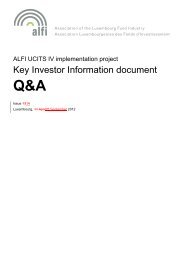Real Estate Investment Funds: Financial reporting - Alfi
Real Estate Investment Funds: Financial reporting - Alfi
Real Estate Investment Funds: Financial reporting - Alfi
Create successful ePaper yourself
Turn your PDF publications into a flip-book with our unique Google optimized e-Paper software.
understand the nature and potential size of<br />
the contingency when the possibility of any<br />
outflow is more than remote.<br />
d. Where performance fees are an accrual or<br />
invoiced liability, the best estimate of the<br />
accrual or the actual amount of the liability<br />
is recorded as such in the balance sheet. Such<br />
performance fee accruals or liabilities are<br />
recorded as an expense of the fund, similar<br />
to management or other similar fees.<br />
e. The need to accrue or record a payable for a<br />
performance fee in the financial statements in<br />
a given period is based on certain triggering<br />
events occurring in that period, for example<br />
reaching financial targets such as cumulative<br />
IRR targets or profit targets. Accruals (as<br />
opposed to payables) are recorded when such<br />
liability has not yet been invoiced or has not<br />
yet become payable as it is subject to a<br />
delayed payment clause or claw back<br />
mechanism under the terms of the<br />
performance fee model.<br />
f. The amount accrued should represent the<br />
best estimate of the most likely amount to<br />
be ultimately paid based on financial<br />
performance up to the cut-off date, using<br />
the most recent and reliable information<br />
available. Accruals for performance fees<br />
may vary from period to period depending<br />
on changes in such information over time,<br />
and the impact of claw back, high<br />
watermark, catch-up and other similar<br />
contractual clauses.<br />
g. Performance fees can also be paid as equity<br />
instruments in the fund as opposed to cash.<br />
Generally, in such cases, the estimate or<br />
actual value of such equity is recorded in the<br />
equity of the fund. This treatment should<br />
reflect the value of the equity being earned,<br />
vesting and being delivered as actual equity<br />
instruments of the fund. The overall impact<br />
of this treatment is to dilute the equity<br />
attributable to other investors, instead of<br />
recording it as a liability of the fund if it was<br />
payable in cash.<br />
h. In all cases, performance fee arrangements<br />
and transactions are "related party"<br />
transactions of the fund and should be<br />
disclosed in the notes to the financial<br />
statements.<br />
i. The performance fee expense may or may<br />
not be included in the definition of<br />
distributable income of the fund, depending<br />
on the terms of the Fund Documentation.<br />
j. In open ended funds, where investors enter<br />
or leave the fund at different times, there<br />
are mechanisms toensure equal treatment of<br />
investors with respect to performance fees.<br />
These are typically through the issuing of<br />
series of share classes with different terms<br />
with respect to performance fees, or<br />
performance fee equalisation mechanisms<br />
used whenever capital enters or leaves the<br />
fund.<br />
9. What are the typical<br />
accounting treatments<br />
for dividends?<br />
a. Definitions of distributable income are<br />
specified in the Fund Documentation and<br />
will depend on the nature of the fund. Some<br />
definitions are very prescriptive (such as in<br />
income-generating core funds) giving little<br />
discretion to Fund management, while others<br />
give more flexibility. The definition needs to<br />
be aligned with the ability of the fund to<br />
realise cash as well as accounting profits, and<br />
should also allow the accumulation of cash<br />
at the fund level in the structure.<br />
b. In addition, normal corporate law rules on<br />
dividends and distributions may apply,<br />
depending on the choice of vehicle.<br />
c. From an accounting perspective, dividends<br />
are either, in substance,<br />
a contractual liability of a fund and therefore<br />
recognised as accruals in the period in which<br />
they are earned, or<br />
discretionary dividends, payment of which is<br />
dependent on certain approvals as specified<br />
in the Fund Documentation, and are only<br />
recorded in the Fund NAV when approvals<br />
have been made.<br />
d. This will depend of the nature of the fund and<br />
the provisions of the Fund Documentation.<br />
The determination of which of these scenarios<br />
is applicable will set the timing of when the<br />
Fund will declare the Fund NAV to be<br />
ex-dividend.<br />
17

















